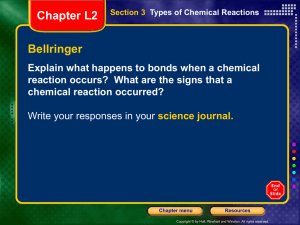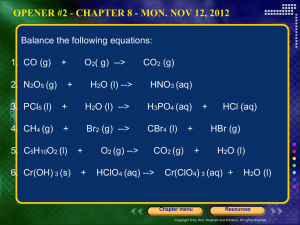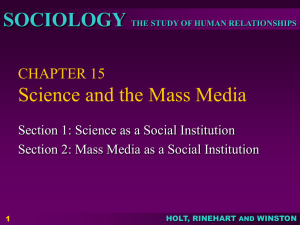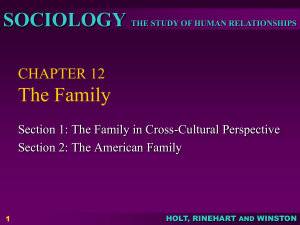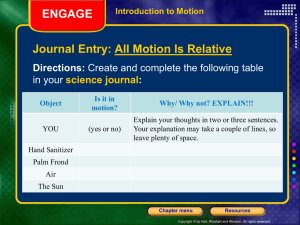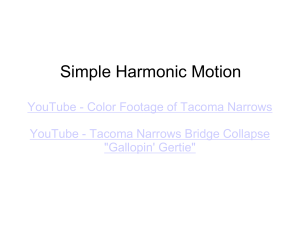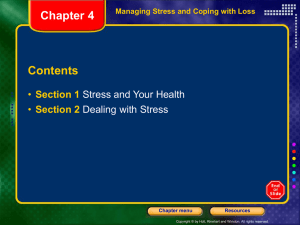power pt on SHM
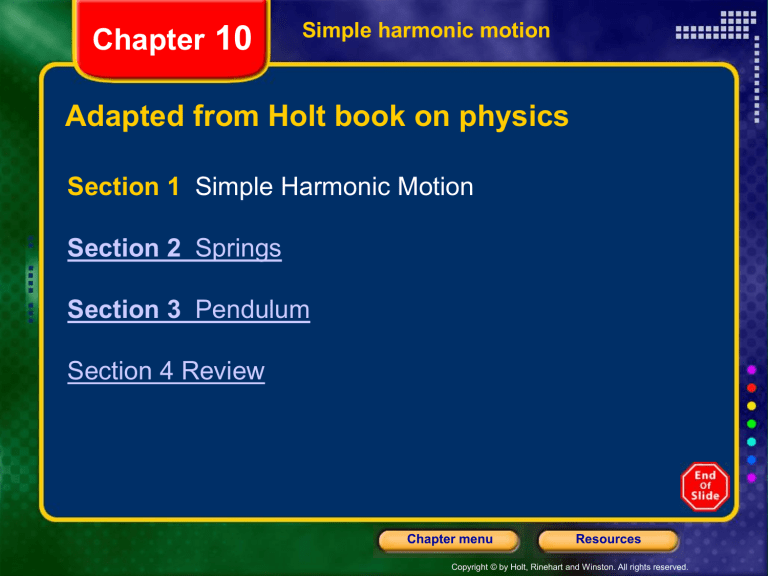
Chapter 10 Simple harmonic motion
Adapted from Holt book on physics
Section 1 Simple Harmonic Motion
Copyright © by Holt, Rinehart and Winston. All rights reserved.
Simple Harmonic Motion
Defn: any periodic motion that is the result of a restoring
force that is proportional to displacement.
Period = T (seconds per cycle)
Frequency = f = 1/T (cycles per second)
Angular frequency = = 2 f = 2 /T
Physics 101: Lecture 22, Pg 2
Chapter 10
Section 1 Simple Harmonic
Motion
Simple Harmonic Motion
Copyright © by Holt, Rinehart and Winston. All rights reserved.
Chapter 10
Section 2 Measuring Simple
Harmonic Motion
Amplitude in SHM
• In SHM, the maximum displacement from equilibrium is defined as the amplitude of the vibration.
– A pendulum’s amplitude
= swing angle from the vertical (
Dq
= radians)
– For a mass-spring system, the amplitude is the maximum amount the spring is stretched or compressed from its equilibrium position. (
D x = meters)
Copyright © by Holt, Rinehart and Winston. All rights reserved.
Chapter 10
Section 2 Measuring Simple
Harmonic Motion
Measures of Simple Harmonic Motion
Copyright © by Holt, Rinehart and Winston. All rights reserved.
Chapter 11
Section 2 Measuring Simple
Harmonic Motion
Amplitude of a pendulum
Copyright © by Holt, Rinehart and Winston. All rights reserved.
Chapter 11
Section 1 Simple Harmonic
Motion
Simple Harmonic Motion
Copyright © by Holt, Rinehart and Winston. All rights reserved.
Chapter 11
Section 1 Simple Harmonic
Motion
Hooke’s Law
• One type of periodic motion is the motion of a mass attached to a spring.
• The direction of the force acting on the mass ( F elastic
) is always opposite the direction of the mass’s displacement from equilibrium ( x = 0).
Copyright © by Holt, Rinehart and Winston. All rights reserved.
Chapter 11
Section 1 Simple Harmonic
Motion
Hooke’s Law, continued
At equilibrium:
• The spring force and the mass’s acceleration become zero.
• The speed reaches a maximum.
At maximum displacement :
• The spring force and the mass’s acceleration reach a maximum.
• The speed becomes zero.
Copyright © by Holt, Rinehart and Winston. All rights reserved.
Chapter 11
Section 1 Simple Harmonic
Motion
Hooke’s Law, continued
• Measurements show that the spring force, or restoring force, is directly proportional to the displacement of the mass.
• This relationship is known as Hooke’s Law:
F elastic
= – kx spring force = –(spring constant displacement)
• The quantity k is a positive constant called the spring constant.
Copyright © by Holt, Rinehart and Winston. All rights reserved.
Chapter 11
Spring Constant
Section 1 Simple Harmonic
Motion
Copyright © by Holt, Rinehart and Winston. All rights reserved.
Chapter 11
Section 1 Simple Harmonic
Motion
Sample Problem
Hooke’s Law
If a mass of 0.55 kg attached to a vertical spring stretches the spring 2.0 cm from its original equilibrium position, what is the spring constant?
Copyright © by Holt, Rinehart and Winston. All rights reserved.
Chapter 11
Section 1 Simple Harmonic
Motion
Sample Problem, continued
1. Define
Given: m = 0.55 kg x = –2.0 cm = –0.20 m g = 9.81 m/s 2
Diagram:
Unknown: k = ?
Copyright © by Holt, Rinehart and Winston. All rights reserved.
Chapter 11
Section 1 Simple Harmonic
Motion
Sample Problem, continued
2. Plan
Choose an equation or situation: When the mass is attached to the spring,the equilibrium position changes. At the new equilibrium position, the net force acting on the mass is zero. So the spring force
(given by Hooke’s law) must be equal and opposite to the weight of the mass.
F
F net
= 0 = F elastic elastic
= – kx
F g
= – mg
– kx – mg = 0
+ F g
Copyright © by Holt, Rinehart and Winston. All rights reserved.
Chapter 11
Section 1 Simple Harmonic
Motion
Sample Problem, continued
2. Plan, continued
Rearrange the equation to isolate the unknown: kx mg 0 kx mg k mg x
Copyright © by Holt, Rinehart and Winston. All rights reserved.
Chapter 11
Section 1 Simple Harmonic
Motion
Sample Problem, continued
3. Calculate
Substitute the values into the equation and solve: k mg x
(0.55 kg)(9.81 m/s 2 )
–0.020 m k 270 N/m
4. Evaluate
The value of k implies that 270 N of force is required to displace the spring 1 m.
Copyright © by Holt, Rinehart and Winston. All rights reserved.
Chapter 11
Section 1 Simple Harmonic
Motion
The Simple Pendulum
• A simple pendulum consists of a mass called a bob, which is attached to a fixed string.
• At any displacement from equilibrium, the weight of the bob ( F g
) can be resolved into two components.
• The x component ( F g,x
= F g sin q
) is the only force acting on the bob in the direction of its motion and thus is the restoring force.
The forces acting on the bob at any point are the force exerted by the string and the gravitational force.
Copyright © by Holt, Rinehart and Winston. All rights reserved.
Chapter 11
Section 1 Simple Harmonic
Motion
The Simple Pendulum, continued
• The magnitude of the restoring force
( F g,x
= F g sin q
) is proportional to sin q
.
• When the maximum angle of displacement q is relatively small
(<15 °), sin q is approximately equal to q in radians.
• As a result, the restoring force is very nearly proportional to the displacement .
• Thus, the pendulum’s motion is an excellent approximation of simple harmonic motion.
Copyright © by Holt, Rinehart and Winston. All rights reserved.
Chapter 11
Section 1 Simple Harmonic
Motion
Restoring Force and Simple Pendulums
Copyright © by Holt, Rinehart and Winston. All rights reserved.
Pendulum
g
L
T
2
2
L g
For “small oscillation”, period does not depend on
•mass
•amplitude
Demos:
M,A,L dependence
Physics 101: Lecture 22, Pg 20
Concept Question
Suppose a grandfather clock (a simple pendulum) runs slow. In order to make it run on time you should:
1. Make the pendulum shorter CORRECT
2. Make the pendulum longer
g
L
T
2
2
L g
Physics 101: Lecture 22, Pg 21
Concept Question
A pendulum is hanging vertically from the ceiling of an elevator. Initially the elevator is at rest and the period of the pendulum is T . Now the pendulum accelerates upward. The period of the pendulum will now be
1. greater than T
2. equal to T
3. less than T CORRECT
g
L
T
2
2
L g
“Effective g” is larger when accelerating upward
(you feel heavier)
Physics 101: Lecture 22, Pg 22
Concept Question
If the amplitude of the oscillation (same block and same spring) was doubled, how would the period of the oscillation change? (The period is the time it takes to make one complete oscillation)
1. The period of the oscillation would double.
2. The period of the oscillation would be halved
3. The period of the oscillation would stay the same CORRECT
+2A x t
-2A
Physics 101: Lecture 22, Pg 23
Potential Energy of a Spring
PE
S
1
2 kx
2
Where x is measured from the equilibrium position
PE
S x=0 m x x
0
Physics 101: Lecture 22, Pg 24
Same thing for a vertical spring:
PE
S
1
2 ky
2
Where y is measured from the equilibrium position y m y=0
PE
S y
0
Physics 101: Lecture 22, Pg 25
Chapter
11
Section 1 Simple Harmonic
Motion
Force and Energy in Simple Harmonic Motion
Physics 101: Lecture 22, Pg 27
Concept Question
In Case 1 a mass on a spring oscillates back and forth. In Case 2 , the mass is doubled but the spring and the amplitude of the oscillation is the same as in Case 1.
In which case is the maximum kinetic energy of the mass the biggest?
1. Case 1
2. Case 2
3. Same CORRECT
Physics 101: Lecture 22, Pg 28
Concept Question
PE = 1 /
2
KE = 0 kx 2 same for both
PE = 0
KE = KE
MAX same for both x=-A x=0 x=+A x=-A x=0 x=+A
Physics 101: Lecture 22, Pg 29
Simple Harmonic Motion:
Quick Review
x(t) = [A]cos( v(t) = -[A ]sin( t) a(t) = -[A 2 ]cos( t) x v a max max max
= A
= A
= A
2
t)
OR x(t) = [A]sin( t) v(t) = [A ]cos( t) a(t) = -[A 2 ]sin( t)
Period = T (seconds per cycle)
Frequency = f = 1/T (cycles per second)
Angular frequency = = 2 f = 2 /T
Physics 101: Lecture 22, Pg 31
Review: Period of a Spring
For simple harmonic oscillator
= 2 f = 2 /T
For mass M on spring with spring constant k
k m
T
2
m k
Demos:
A,m,k dependence
Physics 101: Lecture 22, Pg 32
Chapter 11 Standardized Test Prep
Multiple Choice
Base your answers to questions 1 –6 on the information below .
A mass is attached to a spring and moves with simple harmonic motion on a frictionless horizontal surface.
1. In what direction does the restoring force act?
A.
to the left
B.
to the right
C.
to the left or to the right depending on whether the spring is stretched or compressed
D.
perpendicular to the motion of the mass
Copyright © by Holt, Rinehart and Winston. All rights reserved.
Chapter 11 Standardized Test Prep
Multiple Choice, continued
Base your answers to questions 1 –6 on the information below .
A mass is attached to a spring and moves with simple harmonic motion on a frictionless horizontal surface.
2.
If the mass is displaced –0.35 m from its equilibrium position, the restoring force is 7.0 N. What is the spring constant?
F.
–5.0
10
–2
N/m
G.
–2.0
10 1 N/m
H.
5.0
10
–2
N/m
J.
2.0
10 1 N/m
Copyright © by Holt, Rinehart and Winston. All rights reserved.
Chapter 11 Standardized Test Prep
Multiple Choice, continued
Base your answers to questions 1 –6 on the information below .
A mass is attached to a spring and moves with simple harmonic motion on a frictionless horizontal surface.
2.
If the mass is displaced –0.35 m from its equilibrium position, the restoring force is 7.0 N. What is the spring constant?
F.
–5.0
10
–2
N/m
G.
–2.0
10 1 N/m
H.
5.0
10
–2
N/m
J.
2.0
10 1 N/m
Copyright © by Holt, Rinehart and Winston. All rights reserved.
Chapter 11 Standardized Test Prep
Multiple Choice, continued
Base your answers to questions 1 –6 on the information below .
A mass is attached to a spring and moves with simple harmonic motion on a frictionless horizontal surface.
3.
In what form is the energy in the system when the mass passes through the equilibrium point?
A.
elastic potential energy
B.
gravitational potential energy
C.
kinetic energy
D.
a combination of two or more of the above
Copyright © by Holt, Rinehart and Winston. All rights reserved.
Chapter 11 Standardized Test Prep
Multiple Choice, continued
Base your answers to questions 1 –6 on the information below .
A mass is attached to a spring and moves with simple harmonic motion on a frictionless horizontal surface.
3.
In what form is the energy in the system when the mass passes through the equilibrium point?
A.
elastic potential energy
B.
gravitational potential energy
C.
kinetic energy
D.
a combination of two or more of the above
Copyright © by Holt, Rinehart and Winston. All rights reserved.
Chapter 11 Standardized Test Prep
Multiple Choice, continued
Base your answers to questions 1 –6 on the information below .
A mass is attached to a spring and moves with simple harmonic motion on a frictionless horizontal surface.
4.
In what form is the energy in the system when the mass is at maximum displacement?
F.
elastic potential energy
G.
gravitational potential energy
H.
kinetic energy
J.
a combination of two or more of the above
Copyright © by Holt, Rinehart and Winston. All rights reserved.
Chapter 11 Standardized Test Prep
Multiple Choice, continued
Base your answers to questions 1 –6 on the information below .
A mass is attached to a spring and moves with simple harmonic motion on a frictionless horizontal surface.
4.
In what form is the energy in the system when the mass is at maximum displacement?
F.
elastic potential energy
G.
gravitational potential energy
H.
kinetic energy
J.
a combination of two or more of the above
Copyright © by Holt, Rinehart and Winston. All rights reserved.
Chapter 11 Standardized Test Prep
Multiple Choice, continued
Base your answers to questions 1 –6 on the information below .
A mass is attached to a spring and moves with simple harmonic motion on a frictionless horizontal surface.
5.
Which of the following does not affect the period of the mass-spring system?
A.
mass
B.
spring constant
C.
amplitude of vibration
D.
All of the above affect the period.
Copyright © by Holt, Rinehart and Winston. All rights reserved.
Chapter 11 Standardized Test Prep
Multiple Choice, continued
Base your answers to questions 1 –6 on the information below .
A mass is attached to a spring and moves with simple harmonic motion on a frictionless horizontal surface.
5.
Which of the following does not affect the period of the mass-spring system?
A.
mass
B.
spring constant
C.
amplitude of vibration
D.
All of the above affect the period.
Copyright © by Holt, Rinehart and Winston. All rights reserved.
Chapter 11 Standardized Test Prep
Multiple Choice, continued
Base your answers to questions 1 –6 on the information below .
A mass is attached to a spring and moves with simple harmonic motion on a frictionless horizontal surface.
6.
If the mass is 48 kg and the spring constant is 12 N/m, what is the period of the oscillation?
F.
8
G.
4
s
s
H.
s
J.
/2 s
Copyright © by Holt, Rinehart and Winston. All rights reserved.
Chapter 11 Standardized Test Prep
Multiple Choice, continued
Base your answers to questions 1 –6 on the information below .
A mass is attached to a spring and moves with simple harmonic motion on a frictionless horizontal surface.
6.
If the mass is 48 kg and the spring constant is 12 N/m, what is the period of the oscillation?
F.
8
G.
4
s
s
H.
s
J.
/2 s
Copyright © by Holt, Rinehart and Winston. All rights reserved.
Chapter 11 Standardized Test Prep
Multiple Choice, continued
Base your answers to questions 7 –10 on the information below .
A pendulum bob hangs from a string and moves with simple harmonic motion.
7.
What is the restoring force in the pendulum?
A.
the total weight of the bob
B. the component of the bob’s weight tangent to the motion of the bob
C.
the component of the bob’s weight perpendicular to the motion of the bob
D.
the elastic force of the stretched string
Copyright © by Holt, Rinehart and Winston. All rights reserved.
Chapter 11 Standardized Test Prep
Multiple Choice, continued
Base your answers to questions 7 –10 on the information below .
A pendulum bob hangs from a string and moves with simple harmonic motion.
7.
What is the restoring force in the pendulum?
A.
the total weight of the bob
B. the component of the bob’s weight tangent to the motion of the bob
C.
the component of the bob’s weight perpendicular to the motion of the bob
D.
the elastic force of the stretched string
Copyright © by Holt, Rinehart and Winston. All rights reserved.
Chapter 11 Standardized Test Prep
Multiple Choice, continued
Base your answers to questions 7 –10 on the information below .
A pendulum bob hangs from a string and moves with simple harmonic motion.
8.
Which of the following does not affect the period of the pendulum?
F.
the length of the string
G. the mass of the pendulum bob
H.
the freefall acceleration at the pendulum’s location
J.
All of the above affect the period.
Copyright © by Holt, Rinehart and Winston. All rights reserved.
Chapter 11 Standardized Test Prep
Multiple Choice, continued
Base your answers to questions 7 –10 on the information below .
A pendulum bob hangs from a string and moves with simple harmonic motion.
8.
Which of the following does not affect the period of the pendulum?
F.
the length of the string
G. the mass of the pendulum bob
H.
the freefall acceleration at the pendulum’s location
J.
All of the above affect the period.
Copyright © by Holt, Rinehart and Winston. All rights reserved.
Chapter 11 Standardized Test Prep
Multiple Choice, continued
Base your answers to questions 7 –10 on the information below .
A pendulum bob hangs from a string and moves with simple harmonic motion.
9.
If the pendulum completes exactly 12 cycles in 2.0 min, what is the frequency of the pendulum?
A.
0.10 Hz
B. 0.17 Hz
C.
6.0 Hz
D.
10 Hz
Copyright © by Holt, Rinehart and Winston. All rights reserved.
Chapter 11 Standardized Test Prep
Multiple Choice, continued
Base your answers to questions 7 –10 on the information below .
A pendulum bob hangs from a string and moves with simple harmonic motion.
9.
If the pendulum completes exactly 12 cycles in 2.0 min, what is the frequency of the pendulum?
A.
0.10 Hz
B. 0.17 Hz
C.
6.0 Hz
D.
10 Hz
Copyright © by Holt, Rinehart and Winston. All rights reserved.
Chapter 11 Standardized Test Prep
Multiple Choice, continued
Base your answers to questions 7 –10 on the information below .
A pendulum bob hangs from a string and moves with simple harmonic motion.
10.
If the pendulum’s length is 2.00 m and a g
= 9.80 m/s 2 , how many complete oscillations does the pendulum make in
5.00 min?
F.
1.76
G. 21.6
H.
106
J.
239
Copyright © by Holt, Rinehart and Winston. All rights reserved.
Chapter 11 Standardized Test Prep
Multiple Choice, continued
Base your answers to questions 7 –10 on the information below .
A pendulum bob hangs from a string and moves with simple harmonic motion.
10.
If the pendulum’s length is 2.00 m and a g
= 9.80 m/s 2 , how many complete oscillations does the pendulum make in
5.00 min?
F.
1.76
G. 21.6
H.
106
J.
239
Copyright © by Holt, Rinehart and Winston. All rights reserved.
